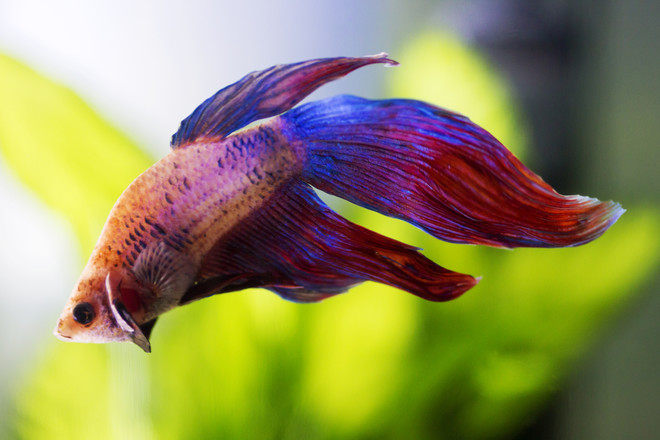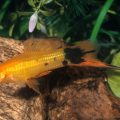 Beautiful aquarium fish Photo: Getty
Beautiful aquarium fish Photo: Getty
Photo and description of aquarium fish alphabetically
Representatives of the Belontiev family haveA special organ that allows them to breathe atmospheric air. It is called a labyrinth. Because of it, such inhabitants of aquariums are also called labyrinth. Additional oxygen is vital for them. Such fish can not be kept in aquariums covered with surface glass - they can suffocate. Otherwise, care for them is not complicated. The most popular of this family among aquarists are different types of anabas, gourami, macropods and, of course, cockerels. Petushkov is also called fighting fishes for their cocky temper. It seems that the photos of these bright aquarium fish do not match the name - they look impressive handsome. But the same males fighting betta will not long be flaunted with luxurious veil fins, if they live together. Fights and tearing off the tails are inevitable. Without competition, they also can not - wither. The ideal solution is to settle a few females and one male and put a mirror in the aquarium. Funny fish are inactive. They like to hide at the bottom in the ground, completely merging with it thanks to funny stripes and specks. The most private inhabitants of artificial reservoirs from this family are various kinds of acantholphus and bots. Aquarium fish from the numerous Karpov family are frequent owners of decorative water suites. Labeo, zebrafish, barbuses, rumors, cardinals are not at all aggressive, they get on very well with neighbors, unpretentious. Goldfish are rightfully considered to be the beginners of aquarists. Many species with different colors are derived from them: coal-black to flaming red. These are voylechvosts, telescopes, comets, and shubunkins. Large, bright and friendly, they really fulfill the desire of owners not to part with the pet as long as possible. After all, such water inhabitants live from 15 to 35 years. Multicolored representatives of the Peciliev family are unpretentious for feeding and keeping conditions. Owners of artificial reservoirs are very fond of:
- platipecili;
- swordsmen;
- mollieseniasis;
- gyrardines;
- guppy.
If you decide to purchase an aquarium for a child,The first of its inhabitants should be guppies. They are absolutely not exacting in care and perfectly get along with different kinds of peace-loving fish. Perhaps, it is not worthwhile to settle them only together with fast-moving fish like barbs. Otherwise, males will begin to arrange "disassembly" and lose their luxurious tails. Haratsinids are beautiful, bright and mostly peaceful. In addition, perhaps, piranhas - they also belong to this family. Most often, neon, ornaments, tetra and pack are produced. But there are also connoisseurs of predatory piranhas. Cichlids are valued not only for external beauty, but also for an unusual lifestyle. Watching them is extremely interesting. So, their way of reproduction and care of the offspring is very extravagant. Females can attach caviar to stones or leaves, bury them in the ground and even store in the mouth. To eat, the parents pass the eggs to each other. In case of danger, eggs, and newly hatched fry, hide in their mouths to their mother or father. Of the cyclides in domestic aquariums are often found acary, apistograms, discus, scalaris, cichlazomas and parrots. Very beautiful astronotus or peacock eye. It is a large fish with a calm, even timid character. She needs a spacious habitat and companions of about the same size. A trifle can accidentally suffer from a bulky neighbor.
Inhabitants of aquariums from detachment of catfish
Somikov is loved for his calm nature, unusual body structure and, of course, a luxurious mustache. Breeders derived a lot of aquarium variants from different families:
- Feminine catfish differ in gay spottedcolor and three pairs of whiskers, two of which are covered with a peculiar fringe. For this representatives of this family and got its name. The most popular are various types of sidontis - angel, cuckoo, flag, flip-flop
- The family of Bronyakovs, which includes acanthodoruschocolate and stellate, white-spotted Agamikis, Hankok's amlidoras, striped platidoras, are also named because of external features. Their bodies, as it were, are cut with bone plates. These fish developed intestinal breathing in the course of evolution: from time to time they need to take a breath of atmospheric air. In completely enclosed aquariums, they will die.
- Kallihtovye (armored) catfish are equipped with bone plates on the sides. These are peace-loving bottom fish, the most popular of which are dianemes, corridors, tarakatum.
- Loricarians or chained catfish lookmost bizarrely. They are clad in "chain mail" from the fused bony fins, reminiscent of the lorik - the armor of the ancient Roman legionaries. Representatives of this large family, for example, ancistrus, ototsinlyuksy and lorikarii, unlike other catfish, are not predators. They feed on algae and leaves of aquatic plants.
- Representatives of the Pimelodov family(flatheads) outwardly resemble the killer whale in miniature. They have a beautiful mottled or striped color and three pairs of mustaches. Especially good are the Harlequin, a Pimedolus, and a painted and painted.
- Hack-catfish have a giant head and mouth, but they have only two antennas. They are awake and hunting at night. Coloring allows them to merge with the bottom and attack prey from an ambush.
- Shilba catfishes live not on the bottom, but on the surface or in thickets of algae. There are translucent and even transparent, like glass, fish.
- The family Shirokogolovyh includes a bunocephalus or som-snag. He leads a nocturnal life, and hides in the day in shelters, so masterfully that only a very attentive ichthyologist can notice him.
There are among the catfish and dangerous species, whichDo not start a beginner. This is a sack-brisk soma with their sharp poisonous spines and electric catfishes. They have a special body that emits a charge of current sensitive to the person and neighbors in the aquarium. Having decided to get aquatic residents, familiarize yourself with the conditions of their habitat, feeding, and also the attitude towards their neighbors. Consider the temperament of pets is very important. Trying to combine nimble and calm fish can lead to unpleasant consequences. Read more:









